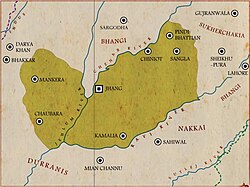Sial State | |||||||||
|---|---|---|---|---|---|---|---|---|---|
| c. 1727–1816 | |||||||||
 Map of the state of Jhang in Punjab in the mid-18th century | |||||||||
| Status | Chieftainship | ||||||||
| Capital | Jhang | ||||||||
| Common languages | |||||||||
| Ethnic groups | Punjabis (with the Sials being the dynastic rulers) | ||||||||
| Religion | Islam (dynastic) | ||||||||
| Chief | |||||||||
• 1723 – 1747 | Walidad Khan Sial (founder) | ||||||||
• 1747 – 1787 | Inayatullah Khan Sial | ||||||||
• 1787 – 1798 | Sultan Kabir Khan Sial | ||||||||
• 1798 – 1816 | Ahmad Khan Sial (last) | ||||||||
| Area | |||||||||
• Total | 6,007[1] sq mi (15,560 km2) | ||||||||
| |||||||||
| Today part of | Pakistan | ||||||||
Sial dynasty was a Punjabi Muslim chieftaincy that ruled over the Sial state[2] (c. 1727–1816) in central Punjab during the 18th and 19th centuries. It was centred around the city of Jhang.[3][4]
- ^ Cite error: The named reference
gwas invoked but never defined (see the help page). - ^ Gilmartin, David (2020). Blood and Water: The Indus River Basin in Modern History. University of California Press. p. 93. ISBN 978-0-520-35553-8.
- ^ Zahab, Mariam Abou (2020). Pakistan: A Kaleidoscope of Islam. Oxford University Press. pp. 68–69. ISBN 978-0-19-753459-5.
Jhang is located about 200 kilometres south of Lahore. It had historically a great politico-strategic importance for two reasons: the Sial dynasty was once powerful and Jhang was situated on the main communication line between Lahore and Multan. Parts of the vast district were taken away by the British and later by the Government of Pakistan when they created new districts. Today Jhang consists of three tehsils: Jhang, Chiniot and Shorkot.
- ^ Gupta, Hari Ram (1991). The Sikh Lion of Lahore (Maharaja Ranjit Singh, 1799–1839). History Of The Sikhs. Vol. V. Munshiram Manoharlal. pp. 65–66. ISBN 978-8-121-50515-4.
